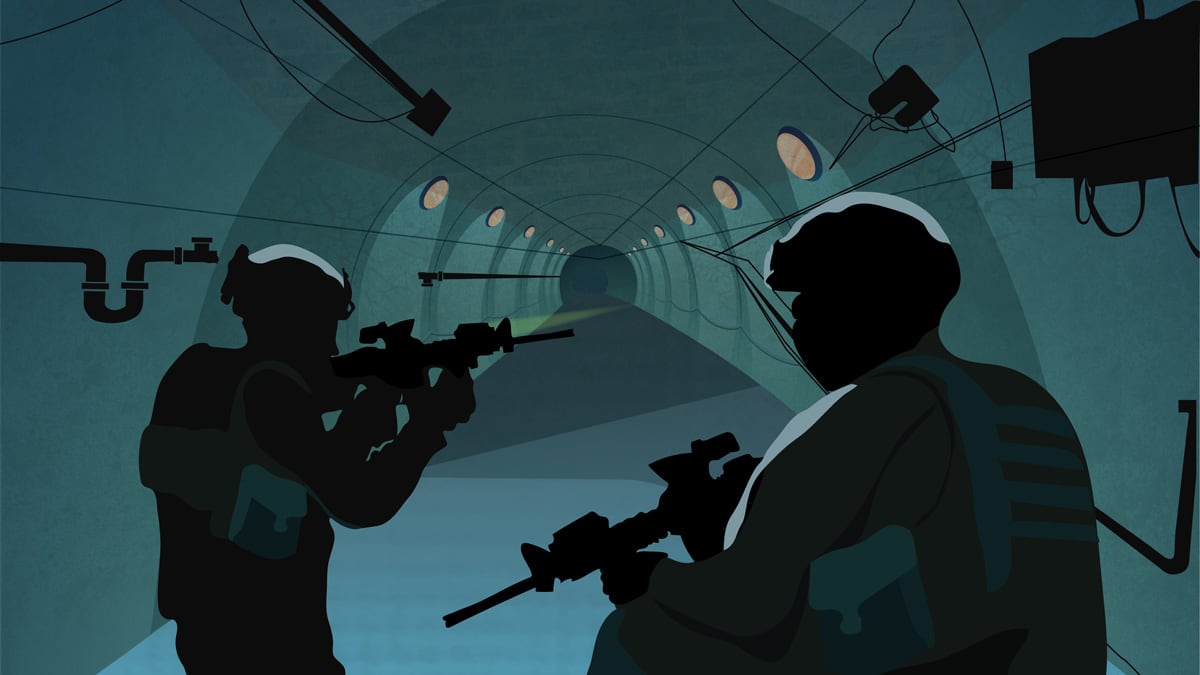“Sir, what do you want us to do about the tunnel?” a Marine squad leader asked during a rotation through the Range 220 urban complex at the Marine Corps Air Ground Combat Center at Twentynine Palms, California.
“Seal it, post security, and we’ll deal with it later,” the rifle platoon commander replied.
Earlier this year, that platoon commander, Marine Corps 1st Lt. Walker Mills, wrote a critique on the Modern War Institute website on the lack of underground training he saw while serving as a rifle platoon commander with 2nd Battalion, 1st Marine Regiment.
“Nowhere in my training had tunnels come up or been addressed as a tactical problem,” he wrote.
Tunnels and underground threats have faced military leaders for centuries, if not millennia. But how Marines will tackle the problem is still in its infancy.
As the Army pushes specialized trainers out to brigade combat teams to build underground battle skills, the Marine Corps has constructed its own simulated underground fighting section at its combat center and is figuring out what formations will deal with the growing subterranean threat.
RELATED

Marine Corps Times embedded with soldiers with the Army’s 82nd Airborne Division in February as they went through a week-long training package put out by the service’s Maneuver Center of Excellence and the Asymmetric Warfare Group.
The training consisted of a lot of room clearing in blackout conditions and practice breaching and planning for limited or polluted air supply and compromised communications.
Recently, Marine Times Corps Times interviewed Chief Warrant Officer 4 Brian Somers, who’s the gunner for the Marine Air Ground Task Force Training Command.
Somers said that about two years ago Commandant Gen. Robert Neller visited the combat center during unit training and asked a simple question, “What are we doing about subterranean?”
It was at about that same time that Army leaders were developing their own manual and figuring out what equipment and personnel they would need to meet the growing problem of underground complexes, which are a component of near-peer and unconventional warfare terrain.
Though there are some subterranean features at the MCCAGC training complex and other locations, it wasn’t previously planned for as a threat trainees confront directly, Somers said.
Somers said that the Marines partnered with the Combating Terrorism Technical Support Office which serves as a “community of interest” that leads work on the subterranean problem.
Since then, the training command has put together a 160-meter stretch of shipping containers that are a blacked out, sealed training facility. It’s above ground but otherwise mimics the environment that Marines must face, at least at a small scale.
That saw its first full rotation go through in late 2018, he said.
There are curves, twists, turns and an up and down elevation. During the six-day block of urban training that a battalion will receive in their overall integrated training exercise they’ll put one platoon through at a time. That training includes urban assault, urban patrol, counter improvised explosive device and counter mobility.
The subterranean portion comes during the assault phase, Somers said.
The platoon gets formal instruction, vignettes and discussion about how to deal with underground threats. They then move through it as though it were part of the larger urban complex, using reporting procedures.
Somers likens it to past IED training.
“If you see something that looks suspect, go through the reporting process,” he said.
That informs the intelligence cycle and describes the threat for higher headquarters.
Then they go inside.
Movement techniques are similar to room-clearing tactics, Somers said. But they’ve got to deal closely with the lack of ambient light, how to move and communicate when night vision and radios don’t work.
Often, Marines revert to using white light to illuminate the area and help their night vision work, Somers said.
But, he admits that a platoon sized element can’t fully work in that space, and a larger space, such as a 500- to 1,000-meter area, would eat up the manpower of a standard rifle platoon pretty quickly.
The big questions still being worked out are how the Marines will task, organize and equip for an underground fight.
“I think we need to identify the problem, frame it as to who is responsible to this counter tunneling mission and how to train, man and equip for it,” Somers said.
Somers, a career infantryman, sees infantry as more of a security element that would protect engineers with their specific gear such as robots and other devices.
At this point, the work they’re doing is to challenge Marines at the tactical level to think about the problem, report all the intel they can.
“We run them through a live training environment so commanders, small unit leaders can start thinking about this as we look at major combat operations spanning the globe,” Somers said.
They’ll need to develop a plan of action with some milestone to see how infantry, supported by engineers and special operations forces, can meet underground threats.
The gunner draws some of his own experience when discussing the challenges. While on a 2004 combat tour in Najaf, Iraq, he said they dealt with insurgents who’d set up a command center in a parking structure near a major mosque.
They used it to avoid detection as an additional layer of cover to protect against Marine weapons, he said. The Marines didn’t have a lot of information about what their adversaries were doing for exactly that reason.
“We had no clue what was going on down there,” Somers said.
Todd South has written about crime, courts, government and the military for multiple publications since 2004 and was named a 2014 Pulitzer finalist for a co-written project on witness intimidation. Todd is a Marine veteran of the Iraq War.





